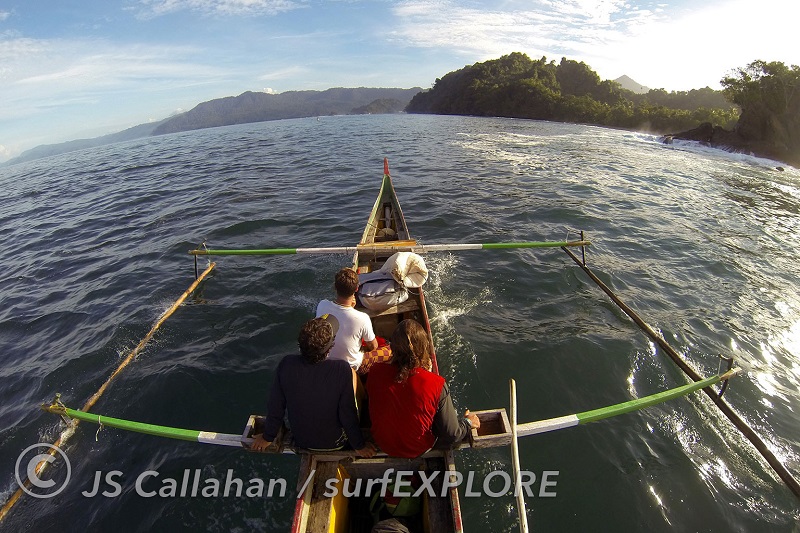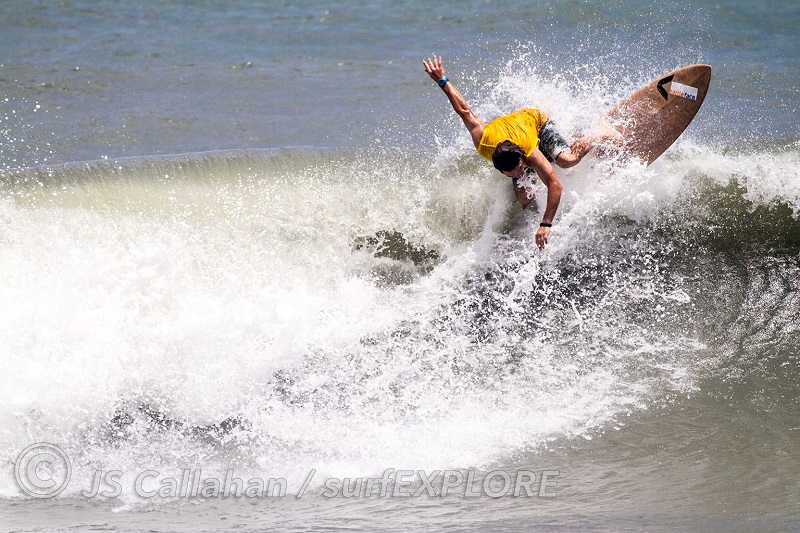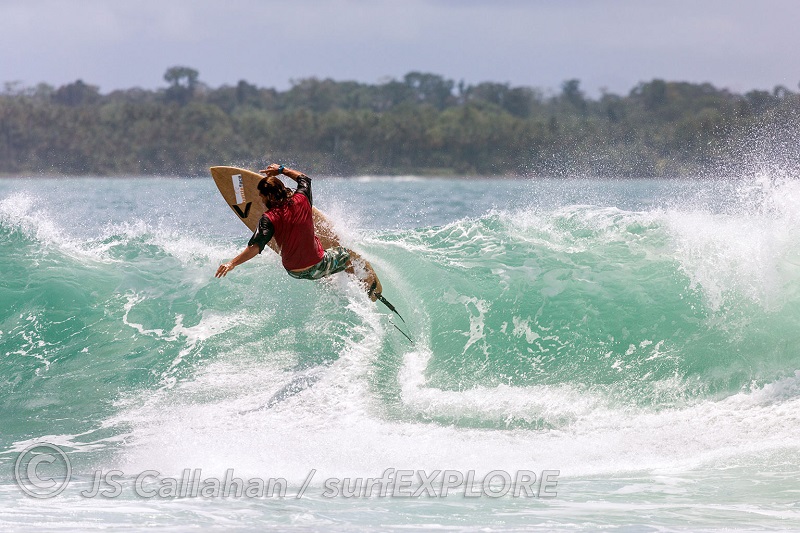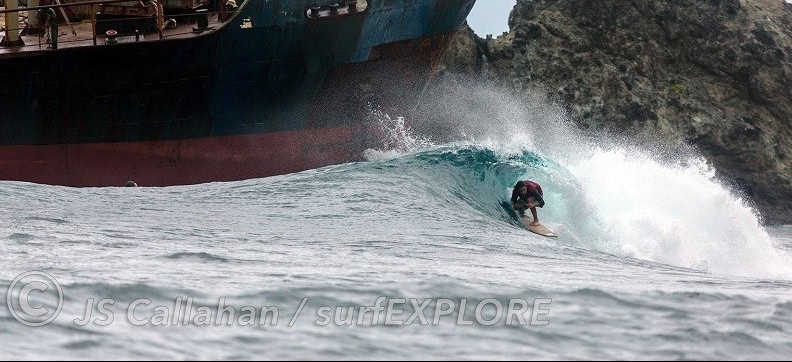Imagination – Travel starts in the mind. The imagination prepares the senses for a deeper experience through rehearsal, just as the musician imagines a performance and the surgeon an operation before the event.
A promised exploration through the un-chartered waves of Pacific Indonesia conjures up jewels in a blueblack ocean, where sand and swordfish meet, where birds suck pollen from orchids and, most vividly, where billions of polyps grow, die and form razor-sharp white coral reef beds – skeletons upon which cylindrical perfect waves may or may not break. The mind always starts the journey before the body sets in motion. The imagination pictures you locked into one of those perfect barrels so that time, for a moment, is frozen, and you glide over the razor coral as the wave spits you out in its last gasp before its whole gathered energy is finally spent. This shortest of journeys – the ultimate experience that is the tube ride – is the product of the meeting point of two long trips, that of the travelling surfer and that of the travelling wave, both long-haul veterans.
Indonesia: 54,716 kilometers of coastline and culture
Indonesia has long been recognised as a surfing mecca with 54,716km of coastline spread around 17,000 islands to explore (11,000 of which are uninhabited). With over 240 million people (the world’s fourth largest population), 300 languages, mosques, chapels and temples, Indonesia is also a rainbow spectrum of culture and landscape. Arguably it was photographer and magazine editor Alby Falzon who first turned the surfing spotlight on the country, unveiling Bali with his iconic slides of Uluwatu published in Tracks magazine and perfect waves in the 1972 surf movie Morning of the Earth.
Barrels in Bali
Myth often defines the habits of a culture and the Balinese have traditionally feared the ocean gods. This outlook was shattered when surfers took to their waves, paddling in unharmed, and by the mid-1970s Bali was the hottest new spot for the global surf traveller – an enchanting lone Hindu enclave in an overwhelmingly Islamic nation. The ocean in Balinese lore was supposedly populated with evil creatures and spirits of the dead. Imagine being the first Balinese surfer, where breaking the local taboo must have been far more risky than the presence of sea snakes and bone-crushing barrels.
Searching for the perfect wave
By the 1990s it became apparent that Indonesia was filled with a seemingly endless mix of perfect waves, most throughout the south and south west facing coast of Sumatra, Java, Bali, Lombok and Sumbawa. King of them all was Grajagan’s enormous coral-studded lava reef in southeast Java which became the site of the original surf camp. Today 200 people might be found crowding the wave on a good swell. It is hard not to meet a travelling surfer these days who has not experienced first hand the sweet smell of kreteks (clove cigarettes) and the smiling faces of Indonesian children. It was inevitable that the locals would eventually produce their own world-class surfers, like Rizal Tanjung and Dede Suryana. Subsequently a plethora of breaks around the globe from cyclonic Teahupoo to towering Cortes Bank have broadened our sense of perfection, but new discoveries are still being mapped in Indonesia, by locals and travellers. The ‘ultimate ride’ is constantly evolving and the perfect wave itself is subjective. The Maldives or Mauritania, who you are with or how you are surfing, everybody’s perception of perfection varies. That is the beauty of surfing.
Uncrowded liquid paradise
Long before the era of the global surfer, the period from 1450 to 1750 was the golden age of European Exploration, as mariners, traders and settlers touched every continent except Antarctica: a time when the world’s coastlines were first reproduced in map form. The once interior ‘blank spaces’ of continents, terra incognita, have now been charted, but for surfers the atlas is still being drawn. Waves await discovery and the world of surf travel encompasses countless Cooks and Columbuses. Ever since that moment at Cape St Francis in The Endless Summer (1966) film when director Bruce Brown narrated, “on Mike’s (Hynson) first ride, he knew he’d finally found that perfect wave,” surfers continue to move light-footed through Asia, Central America, Africa and the Pacific on an obsessive quest for an uncrowded liquid paradise.
Exploration
Surf exploration and the Age of Discovery share a common code of adventure. Today we clearly have the advantage of two co-ordinates, whilst the early explorers only had one. In fact the transformation of circumnavigation from hit and miss adventure to orchestrated expedition was not accomplished until the mid 18th Century when the British government offered a prize of £20,000 for anyone who ‘could discover longitude at sea.’ Infamous mariners, like Captain James Cook, ambitious to sail, in his own words, “not only further than man has been before me but as far as I think is possible for man to go,” flourished under the guide of John Harrison’s exquisitely accurate chronometer. But in the early art of navigation, where longitude was guessed from the stars, the elements moulded mariners’ routes. The winds, the energy that carried sailors across the oceans, were subject to both prolific romantic myth and scientific speculation. Just as Ferdinand Magellan’s pioneering Pacific crossing (between 28th Nov 1520 and 6th March 1521) was made diagonally between Chile and Guam with northwest trade winds, the ocean dictates our search for surf. Bathymetry, oceanography, geology, swell and tide are our co-ordinates at surfEXPLORE. But cultural context and political situations are equally important.

Whether or not that rumoured wave really is world-class is a question of separating myth from reality, just like the European story of exploration represented a concern to move from myth to map, converting cosmological theory into cartographical fact. However, the explorers and cartographers were themselves participating in myth making through their own imaginative tales, in the same style that surfers do upon returning from their adventures.
Chasing legends
Right now stories from extraordinary trips circulate the surfing community, becoming more and more animated. One suite of myths become replaced by another. Tales and legends of far away places flourished in the history of exploration. Magellan remained convinced of the existence of Patagonian giants. At the mouth of the Orinoco, Columbus supposed he was close to the site of the Garden of Eden, and the story of El Dorado continues to inspire Central and South American travel. A similar myth inspired Californian surfers Kevin Naughton and Craig Peterson to travel off-the-beaten track throughout the 1970s remapping and renaming many of the world’s most remote and never-before surfed coastlines. Exotic exploration soon became the surfing speciality as thousands of low-budget travellers fanned out across the world.
surfEXPLORE
Led by legendary Singapore-based photographer John Callahan, surfEXPLORE have been pioneers in documenting pristine surf in Indonesia, with particular focus in recent years on the Pacific coast, where empty line-ups abound in even in an age of mass-consumerism and digital devices. “People have always been compelled to seek out new frontiers and travel is an important part of our surf culture,” says John. “The easy picking, low hanging fruit has been taken, but with research, time and money there are a lot of un-ridden waves to explore.” While surfEXPLORE is in principle the antithesis to war correspondence, we share the same love for the impact zone – far-flung corners destined for the adventurous.

Happiness and surprise
From the Maluku Islands to Sulawesi to Papua, Pacific Indonesia has an incredible variety of unmapped surf breaks. While the Indian Ocean surf season is from April to September (also the dry season) – served by swells coming from the south and southwest and mininmal local wind – between November and April the Pacific coast receives swell from northwest monsoon winds. This coincides with the rainy season – a small price to pay for experiencing ancient evergreen forest, unbroken save for ribbons of cascading water, dazzled eyes, the sweet smell of copra smoke and communities far removed from the growing chaos and carbon monoxide fumes of urban Indonesia. There are six emotions shown through the face: happiness, sadness, anger, fear, disgust and surprise. You will only needed the first and last – happiness and surprise – to communicate the essence of surfing and sharing between cultures.
The reign of secrecy
Discovering un-ridden waves and a few potentially world-class breaks throughout the Pacific coast begs the question: Do we want to broadcast the location? The reign of secrecy plays an important role in the surf culture, as it did in the age of discovery. “This wasn’t a game of show and tell,” reflected Kevin Naughton from his pioneering 1970s travels. Prince Henry the Navigator and his Portuguese successors, who orchestrated a programme of exploration culminating in Vasco da Gama’s voyage beyond Cape Horn to India between 1487-89, did everything to have a monopoly over commerce and newly discovered coasts of Africa. This meant not letting out the word about where and how. Knowledge becomes capital. Grajagan’s early surf pioneer Mike Boyum was grossing $250,000 annually by 1984 for the rights to enjoy his creation: the world’s first surf camp.
Local surf communities
Emi Cataldi explains, “At surfEXPLORE we are clearly aware of the potential benefits and challenges of surf tourism in remote coastal communities. In many areas (such as Sierra Leone), broadcasting specific detail is only a benefit to inspire more visitors to sustain an already existing small-scale tourism community that desperately needs more income. Of course, if a local surf community evolves, it is their agenda to highlight specific spots in a region if they want to develop surf tourism as part of the local economy. This is not the case currently in many parts of Pacific Indonesia. But of course, we never intend to find a ‘perfect wave’, keep it a secret, and surf it alone for ten years. But we do not want to pinpoint specific locations, potentially inundating an area with surf travellers before there are even any local surfers or local facilities to cater for such visitors, and without any longer term dialogue about the needs and desires of the local community. They may want surf tourists in the future, they may not – they have to be the stewards of their coastline.”

Science and surfing
However, surfing is rising rapidily, with current estimates ranging from 20 to 30 million participants. This growing surfing culture is widespread and diverse, exhibiting a significant shift in demographics, including a broadening age range, increasing participation of women, multi-ethnic and multi-ability backgrounds and vulnerable members of society. Erwan Simon explains, “Surfing is addictive. It transforms lives, so we have to find more places to surf. And there is an emerging need to organise the flux of people as surf breaks through sustainable tourism management. Surf travellers can all contribute to the analysis of the surf world by helping to determine the carrying capacity of each wave. It is crucial to know how many riders each break can hold to run a successful surf camp business, manage an emerging local surf community and avoid problems of environmental impacts if surfing is going to continue to rise in popularity.”
John Callahan adds: “The more wave options people have, the lesser the concentration of crowds. If we never went exploring, everywhere would be packed like Malibu in California. But at the same time we don’t want to lose the discovery aspect and kill a lot of people’s adventures. Some places simply are not ready for a surf travel onslaught (like the kind witnessed in the Mentawais over the last two decades, where companies compete for access to waves). In contrast, other areas, including the likes of Haiti, Sierra Leone and Liberia can benefit tremendously from surf travellers. Photos plant the seeds and motivate people to search,” concludes John.
Perils of adventure
The more remote the search, the greater the risks. The lure of the exotic is to romanticise something you don’t have, but the realities of political difficulties can take over, sharp-edged, like coral encounters. This beautiful living structure plays the role of a double-edged sword. Waves break majestically upon her bones, but it is only a matter of time before you pay those coral dues with a hideously infected wound. The warning is that you have to be prepared for anything, from malaria to a military coup, and it’s all at the peril of typhoons, depressions, winds, tide, reef and waves. “The best traveller is versatile,” says Emi Cataldi.
Many modern cultures in the world have refined sedentary lifestyles just as we have refined the bread and sugar upon which that lifestyle depends – moving from couch to occasional pizza grazing. This has produced an epidemic of lifestyle sickness – heart problems from obesity, depression and anxiety grounded in boredom and the need for artificial stimulation. Surf travel offers a contrasting rite of passage against that culture of instant gratification, from the road trip initiation, through the drawn out spontaneity of mapping a coastline, to the deeply uncomfortable experiences that collectively contribute to character forming. “No pain, no gain,” says Erwan Simon, “or, it takes a bit of grit to make a pearl.”

Facing hardship: 1521
During the original circumnavigation voyage, Magellan’s crew went through unspeakable hardships. After miraculously finding his way through the straits that bear his name between Patagonia and the island of Tierra del Fuego, in a nightmarish five week passage (where one of his five-ship fleet mutinied), Magellan and his men went four months without fresh food or water. Many died of scurvy, reduced to eating ox-hides and biscuits that had withered to powder and were swarming with worms, and to drinking putrid yellow water. Magellan gritted his teeth, eventually landing in the Philippines, which seemed like paradise, until he and some of his men were killed by 1,500 Matacan warriors in an inter-tribal war – the price paid for proving that the earth was round.
Facing hardship: 2021
After spotting an incredibly long-looking wave during a plane ride from Jakarta to Bali, Grajagan was ridden in 1972 by Bob Laverty (who was killed a year later in a surfing accident at Uluwatu). Laverty and Bill Boyum, in the true spirit of the surf explorer, motorcycled from Bali, navigated a channel, walked days from the nearest fishing village through inaccessible virgin jungle, infested with malarial mosquitoes and teeming with not always friendly wildlife, to access the wave. The Americans were arrested on the Pleng Kung National Forest Reserve (where the Indonesian Navy carry out military exercises) because they did not have the legal permit required (a constant reminder that a surat jalan – a travel permit easily obtained for a small fee from a police station – is an essential document for any off-the-beaten track surf exploration in Indonesia). Only their Balinese friends saved them from a trip to a Javanese jail at Bangi Wagi. An eight-year Indo resident, Bill’s brother, Mike Boyum, was well versed in the Indonesian way of things and was allowed to build small wooden stilt huts at Grajagan in 1974 to host the globe’s original surf camp. Boyum, however, was arrested and jailed in Vanuatu for cocaine trafficking in 1985 and died four years later on his 45th day of fasting (convinced it was a path to improved health and spirituality) in front of a perfect wave on Siargoa in the Philippines, which John Callahan would photograph in 1992 and name Cloud Nine. Boyum and Magellan, surf explorer and classical mariner both taken to the ends of the earth.

A light footprint
The promise of a perfect wave is not everything. Whether experiencing the earthy side of life amidst red walls born from the Moroccan ground, atoll touring in Tonga, or on a frenzy through Mexico, surf travel is about humble acceptance of local culture. The exhilaration of being surf explorers can be counterbalanced by the embarrassment of being an intruder. Certainly there has been a change of consciousness since European Explorers colonised the ‘New World’ in the age of reconnaissance. The arrogance of European peoples in that period owed much to Christian religious missionary zeal, which saw the Other as barbarian. But unlike the current boom of package holiday tourism, surf explorers are not on the adventure for the sake of going away from home and relaxing from routine. Our motivations are unique in the world of travel. We search for a free and natural phenomenon and have no desire to exploit. As surfers we travel and perform a skill, a drama in someone else’s backyard. Like modern-day troubadours we carry our surfing road show in peace. Maybe that’s why we are accepted. Our demands are low, but our obvious simple pleasure is huge and readily shared.
Making voyages
Moments arise where you feel like you have found your utopia and could happily leave the bustle behind and spend the rest of your days surfing, but then you move on, and the search continues, for you are still surf tourists, bound by other demands. For me the essential lure of travel is the motion, the dynamic; the actual process of physically moving from one scene to another, regardless of the physical hassles involved. There’s something incredibly exciting about the sustained anticipation in a world that should be shared by all. Tennessee Williams’ motto in life was ‘Make voyages.’ The courage to venture into the unknown is a story without end, for the world remains, as Daniel Boorstin says, “a boundless stage for discoveries to come. The most important words ever written on the maps of human knowledge are terra incognita – unknown territory.” And then the oddest thing happens – when you get home, there is some discomfort, things don’t quite fit for a while. This is because the familiar now seems strange, refracted by the experience of travel.

Sam Bleakley | Brilliant Corners








